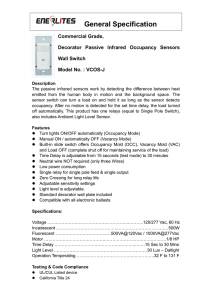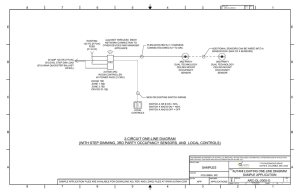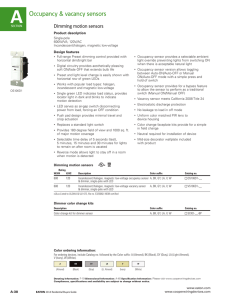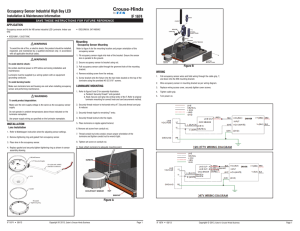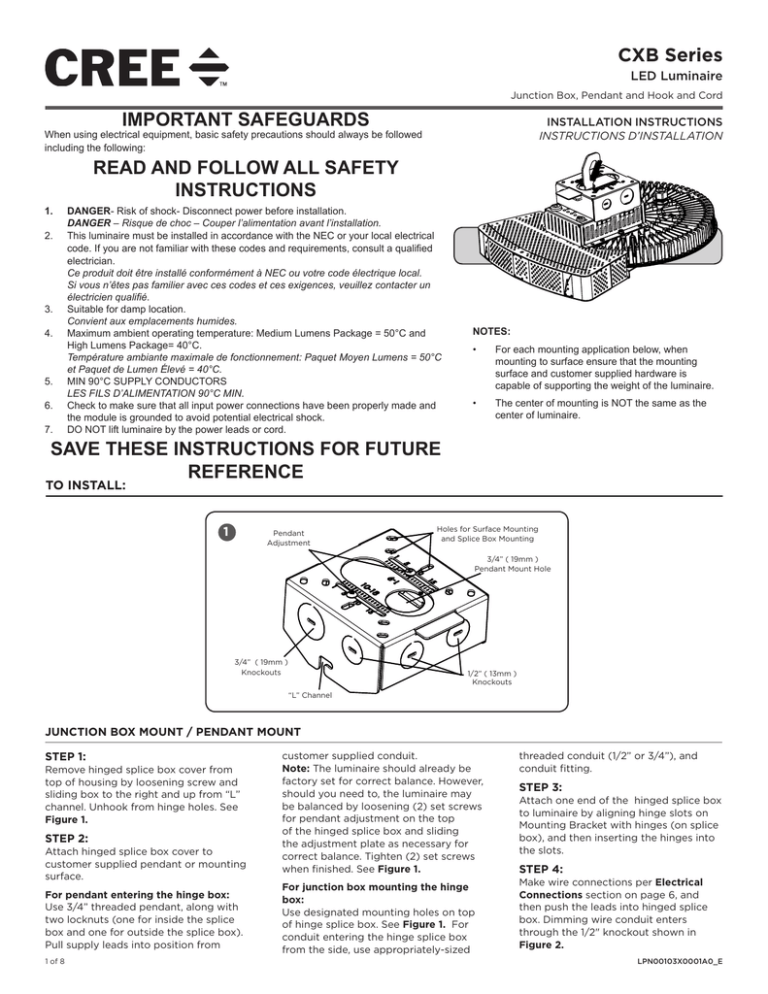
CXB Series
LED Luminaire
Junction Box, Pendant and Hook and Cord
IMPORTANT SAFEGUARDS
INSTALLATION INSTRUCTIONS
INSTRUCTIONS D’INSTALLATION
When using electrical equipment, basic safety precautions should always be followed
including the following:
READ AND FOLLOW ALL SAFETY
INSTRUCTIONS
1.
2.
3.
4.
5.
6.
7.
DANGER- Risk of shock- Disconnect power before installation.
DANGER – Risque de choc – Couper l’alimentation avant l’installation.
This luminaire must be installed in accordance with the NEC or your local electrical
code. If you are not familiar with these codes and requirements, consult a qualified
electrician.
Ce produit doit être installé conformément à NEC ou votre code électrique local.
Si vous n’êtes pas familier avec ces codes et ces exigences, veuillez contacter un
électricien qualifié.
Suitable for damp location.
Convient aux emplacements humides.
Maximum ambient operating temperature: Medium Lumens Package = 50°C and
High Lumens Package= 40°C.
Température ambiante maximale de fonctionnement: Paquet Moyen Lumens = 50°C
et Paquet de Lumen Élevé = 40°C.
MIN 90°C SUPPLY CONDUCTORS
LES FILS D’ALIMENTATION 90°C MIN.
Check to make sure that all input power connections have been properly made and
the module is grounded to avoid potential electrical shock.
DO NOT lift luminaire by the power leads or cord.
NOTES:
•
For each mounting application below, when
mounting to surface ensure that the mounting
surface and customer supplied hardware is
capable of supporting the weight of the luminaire.
•
The center of mounting is NOT the same as the
center of luminaire.
SAVE THESE INSTRUCTIONS FOR FUTURE
REFERENCE
TO INSTALL:
1
Pendant
Adjustment
Holes for Surface Mounting
and Splice Box Mounting
3/4” ( 19mm )
Pendant Mount Hole
3/4” ( 19mm )
Knockouts
1/2” ( 13mm )
Knockouts
“L” Channel
JUNCTION BOX MOUNT / PENDANT MOUNT
STEP 1:
Remove hinged splice box cover from
top of housing by loosening screw and
sliding box to the right and up from “L”
channel. Unhook from hinge holes. See
Figure 1.
STEP 2:
Attach hinged splice box cover to
customer supplied pendant or mounting
surface.
For pendant entering the hinge box:
Use 3/4” threaded pendant, along with
two locknuts (one for inside the splice
box and one for outside the splice box).
Pull supply leads into position from
1 of 8
customer supplied conduit.
Note: The luminaire should already be
factory set for correct balance. However,
should you need to, the luminaire may
be balanced by loosening (2) set screws
for pendant adjustment on the top
of the hinged splice box and sliding
the adjustment plate as necessary for
correct balance. Tighten (2) set screws
when finished. See Figure 1.
threaded conduit (1/2” or 3/4”), and
conduit fitting.
For junction box mounting the hinge
box:
Use designated mounting holes on top
of hinge splice box. See Figure 1. For
conduit entering the hinge splice box
from the side, use appropriately-sized
Make wire connections per Electrical
Connections section on page 6, and
then push the leads into hinged splice
box. Dimming wire conduit enters
through the 1/2" knockout shown in
Figure 2.
STEP 3:
Attach one end of the hinged splice box
to luminaire by aligning hinge slots on
Mounting Bracket with hinges (on splice
box), and then inserting the hinges into
the slots.
STEP 4:
LPN00103X0001A0_E
STEP 5:
Secure other end of the hinged splice box to luminaire by sliding
screw on Mounting Bracket up and over in “L” channel on the
hinged splice box. See Figure 1.
2
Luminaire Hook
STEP 6:
Secure luminaire to hinged splice box by tightening screw.
Retainer Spring
HOOK AND CORD MOUNT
Hook
Adjustment
NOTE: For connecting the flexible cord to the wiring box for
branch supply, suitable Listed cord connector of the involved
cord size and standard conduit opening shall be used in order to
maintain strain relief.
1/2" Knockout
STEP 1:
3
Push down on retainer spring until top of spring is free of
luminaire hook. See Figure 2.
Loosen
Screws
STEP 2:
Slide hook into securely mounted customer supplied eye hanger
and return retainer spring to original position.
NOTE: The luminaire should already be factory set for correct
balance. However, should you need to, the fixture may be
balanced by loosening the hook adjustment set screw on the
top of the housing and sliding the hook as necessary for correct
balance. Tighten hook set screw when finished. See Figure 2.
STEP 3:
Locate the plug on the luminaire and connect to the proper
socket according to the plug. If there is not a plug make wiring
connections per the Electrical Connections section.
4
REFLECTOR INSTALLATION
STEP 1:
Loosen the (4) screws, shown in Figure 3, at least 0.1 inch from
the heatsink.
NOTE: The view in Figure 3 is of the underside of the luminaire.
STEP 2:
Keyhole Slots
Bring trim into housing and line up the (4) screws from Step 1,
with the keyhole slots on the reflector. See
Figure 4.
STEP 3:
Rotate trim, turn clockwise and tighten the (4) screws from Step
1. See Figure 4.
STEP 4:
5
Wipe reflector clean after installation.
Reflector
Hinge Retainer
Frame Hinge
Mounting Wire Guard
STEP 1:
Secure the hinge retainer and frame hinge to the reflector using
supplied screw and lock nut. See Figure 5.
NOTE: Reflector is pre-punched at position of this installation.
STEP 2:
Swing the wire guard into place and secure to the reflector with
the attached spring latch. See Figure 5.
INSTALLING SAFETY CABLE
6
NOTE: Safety Cable is sold separately as an accessory, please
refer to installation sheet in safety cable packaging for complete
installing instructions.
Heatsink
STEP 1:
Attach one end of the safety cable through the fin of the
heatsink. See Figure 6.
STEP 2:
Safety
Cable
2 of 8
Attach other end of the safety cable to mounting surfaces using
customer supplied hardware.
LPN00103X0001A0_E
PRISMATIC REFLECTOR INSTALLATION
7
STEP 1:
Loosen the (4) screws, shown in Figure 3, at
least 0.1 inch from the heatsink.
NOTE: The view in Figure 3 is of the underside
of the luminaire.
Prismatic Reflector
STEP 2:
Bring Prismatic Reflector and mount ring up
to the housing and lineup (4) screws from
Step 1 with the keyhole slots on the mounting
ring. See Figure 7.
STEP 3:
Rotate mount ring, turn clockwise and tighten
the (4) screws from Step 1. See Figure 4.
STEP 4:
Mount Ring
Wipe reflector clean after installation.
Mounting Lens or Wire Guard
STEP 1:
8
Mounting Ring
Place lens or wire guard onto the bottom of
reflector, and place V-band around lens and
reflector. See Figure 8.
Reflector
STEP 2:
Secure lens or wire guard to reflector by
tightening screw on V-band. See Figure 8.
120-277VAC SENSOR INFORMATION
Screw
NOTE: Figures 9 and 10 show both versions
for 120Vac-277Vac sensor and 347/480Vac
sensor. For 347/480Vac sensor information
please refer to pages 7 and 8 under 340/470
Sensor Information section.
Lens with
V-band
INSTALLING SENSOR
STEP 1:
9
Locate the wire form on the sensor and install
onto the luminaire by inserting the wire form
into the (2) tabs under the driver box. See
Figure 9.
Driver
Box
Driver
Box
Tabs
STEP 2:
Ensure that the senor is leveled. To level the
sensor loosen the screw on the top side of
the sensor, and retighten the screw once the
sensor is leveled. See Figure 10.
Wire
Form
SENSOR DESCRIPTION
Sensor for
347/480Vac
Sensor for
120Vac-277Vac
10
Sensor
Adjustment
Screw
Sensor for
120Vac-277Vac
3 of 8
Sensor for
347/480Vac
The occupancy sensor controls high and
low light levels based on occupancy and
the selected ambient light level setting. The
Ambient Light feature can be used to keep the
lights from turning to high level if the ambient
light level is sufficient.
The sensor uses passive infrared sensing
(PIR) technology that reacts to changes in
infrared energy (moving heat) within the
coverage area. Once the space is vacant and
the time delay elapses (adjustable from 30
seconds to 30 minutes), the luminaire will
turn off or dim. Sensors must directly “see”
motion of an occupant to detect them, so
careful consideration must be given to sensor
placement. Avoid placement where sensor’s
line of sight may be obstructed
IMPORTANT: There is an initial warm-up
period. It may take up to a minute before the
lights turn on due to a sensor warm–up period
required during initial power- up. This occurs
during installation or after a lengthy power
failure only.
LPN00103X0001A0_E
Multi-Level Option Output Multipliers
11
Default Coverage Pattern P/N VM035X15
Coverage Top View
HIGH LUMEN PACKAGE
Coverage Side View Temperature 25°C
40 Ft.
20
OFF
OFF
1
0.12
0.13
2
0.17
0.21
3
0.20
0.26
4
0.24
0.30
5
0.31
0.39
6
0.38
0.47
7
0.45
0.54
High Dim Setting
Power
Multiplier
Lumen Multiplier
0.47
0.57
1
0.60
0.68
2
0.69
0.77
3
0.76
0.82
4
0.78
0.84
5
0.83
0.88
6
0.90
0.94
7
1.00
1.00
10
20
20
20
10
0
15
10
5
0
5
10
15
20
20
10
Sensor Lens Assembly Label
12
CZ814X03R0
SENSOR FEATURES
TIME DELAY Rotary
Switch D
PO
S IT
M IN I O N
UTE S
0
40 Ft.
0
7
30
0
20 ft
10
6
20
Lumen Multiplier
0
0. 5
5
Power
Multiplier
1
1
Multi-Level Option Output Multipliers
15
Low Dim Setting
2
2
3
4
4
6
MEDIUM LUMEN PACKAGE
Low Dim Setting
0
OFF
SENSOR COVERAGE PATTERN
Lumen Multiplier
OFF
1
0.16
0.17
2
0.21
0.23
3
0.22
0.25
4
0.25
0.29
5
0.32
0.36
6
0.38
0.43
7
0.46
0.51
High Dim Setting
0
4 of 8
Power
Multiplier
Power
Multiplier
0.53
Lumen Multiplier
20' (6.1m) optimal mounting height and 40' (12.2 m) diameter
coverage area with a 360° circular pattern. The minium and maximum
mounting heights are 10' (3m) and 30' (9.1m) respectively. Lens
mounting height to coverage radius ratio is 1:1. See Figure 11.
SENSOR ADJUSTMENTS
NOTE: Adjustments to these settings require the user to remove the
sensor lens assembly to access the features listed on page 5; features
are located under the lens assembly. Grasp the lens assembly and
turn it counterclockwise a quarter turn. Do not remove the plastic nut;
it holds the sensor in place. Adjust the Ambient Level switch settings
during daylight hours when ambient light is at desired level. See
PAGE 5 for the full details of the sensor features. Refer to the table
below for default factory setting.
Default Factory Setting
0.58
A
0
0.66
L
1
1
0.61
2
0.68
0.72
H
7
3
0.76
0.80
D
5
4
0.79
0.83
5
0.82
0.85
6
0.88
0.91
7
1.00
1.00
POWER DATA
NOTE: Multipliers are for estimating purposes only.
When the sensor settings are changed, it will impact both the power
consumption and the fixture light output. In order to achieve the
ideal settings for the intended application, consult the following data
charts on the left.
LPN00103X0001A0_E
13
Sensor Factory Settings
AMBIENT LIGHT SETTINGS
LED Indicator
Ambient Photocell
Time Delay Feature
Ambient Light Feature
Low Dimming Feature
High Dimming Feature
Warning: Do Not Touch The Passive
Infrared Sensor Below Lens Assembly
PIR Cell
*Settings displayed in figure are for example purpose only.
Ambient Light
Setting (A)
Feature
0
OSO
1
OSTO
2
OSLA
3
OSHA
4
OSLATO
5
OSHATO
6
LL
7
Test/LH
SENSOR OPERATION - 120-277VAC
HIGH DIMMING FEATURE (H):
The High Dimming feature
(Rotary switch H) has eight possible
settings. See Multi-Level Option Output
Multipliers tables on page 4 for the
complete range available.
NOTE: The sensor will not allow the
maximum rated drive current of the
luminaire to be exceeded.
LOW DIMMING FEATURE (L):
The Low Dimming feature
(Rotary switch L) has eight possible
settings and can be adjusted from an off
position (position 0) to a maximum drive
current (position 7). See Multi-Level Option
Output Multipliers tables on page 4 for the
complete range available.
TIME DELAY FEATURE (D):
The Time Delay feature
(Rotary switch D) has eight possible
settings and can be adjusted from 0.5 min
(position 0) to 30 min (position 7). See
Figure 12 for the complete range available.
Once motion is detected, the lighting level
will remain in high mode until no activity is
detected for the duration of the time delay
cycle that has been selected.
AMBIENT LIGHT FEATURE (A):
The Ambient Light feature
(Rotary switch A) has eight possible
settings and provides the ability to employ
daylight harvesting. It also includes a test
mode, as well as lock low and lock high
settings. See Ambient Light Settings table
above for complete range available – a
more detail description of each setting is
below.
Occupancy Sensing Only (OSO):
Occupancy detection (PIR) enabled only.
Ambient Light sensing
(ambient photocell ) is disabled. The sensor
will switch the luminaire to High mode
during occupancy detection regardless of
environment light levels and will remain so
per selected setting in Time Delay feature.
After no occupancy is detected during Time
Delay cycle, luminaire will switch to Low
5 of 8
mode (factory default).
Occupancy Sensing and Time Off
(OSTO): Occupancy detection (PIR)
enabled only with Time Off operation.
Ambient light sensing (ambient photocell)
is disabled. The sensor will switch the
luminaire to High mode during occupancy
detection regardless of environment light
levels and will remain so per selected
setting in Time Delay feature. After no
occupancy is detected during Time Delay
cycle, luminaire will switch to Low mode.
Sensor will switch the luminaire to Off after
30 minutes of no occupancy detection
(Low mode). The luminaire will move
immediately back into high mode from off
once motion is detected.
Occupancy Sensing and Low Ambient
(OSLA): Occupancy detection (PIR) and
Ambient Light sensing (ambient photocell)
enabled. During transitional periods from
night to day once environment light levels
exceed 130 Lux (12 FC) and no occupancy
is detected for the time delay duration,
luminaire will be turned Off. During
transitional periods from day to night when
environment light levels fall below 80 Lux
(7 FC), luminaire will switch from OFF to
Low mode during no occupancy and switch
to High mode after occupancy is detected.
Occupancy Sensing and High Ambient
(OSHA): Occupancy detection (PIR) and
Ambient Light sensing (ambient photocell)
enabled. During transitional periods from
night to day once environment light levels
exceed 600 Lux (55 FC) and no occupancy
is detected for the time delay duration,
luminaire will be turned Off. During
transitional periods from day to night when
environment light levels fall below 500 Lux
(46 FC), luminaire will switch from OFF to
Low mode during no occupancy and switch
to High mode after occupancy is detected.
Occupancy Sensing, Low Ambient and
Time Off (OSLATO): Occupancy detection
(PIR), Ambient Light sensing (ambient
photocell) and Time Off enabled. During
transitional periods from night to day once
environment light levels exceed 130 Lux
(12 FC) and no occupancy is detected for
the time delay duration, luminaire will be
turned Off. During transitional periods
from day to night when environment light
levels fall below 80 Lux (7 FC), luminaire
will switch from OFF to Low mode during
no occupancy and switch to High mode
after occupancy is detected. Sensor will
switch the luminaire Off after 30 minutes
of no occupancy detection (Low mode).
The luminaire will move immediately back
into high mode from off once motion is
detected and ambient light is less than
approximately 130 Lux (12 FC).
Occupancy Sensing, High Ambient and
Time Off (OSHATO): Occupancy detection
(PIR), Ambient Light sensing (ambient
photocell) and Time Off enabled. During
transitional periods from night to day once
environment light levels exceed 600 Lux
(55 FC) and no occupancy is detected
for the time delay duration, luminaire will
be turned Off. During transitional periods
from day to night when environment light
levels fall below 500 Lux (46 FC), luminaire
will switch from OFF to Low mode during
no occupancy and switch to High mode
after occupancy is detected. Sensor will
switch the luminaire Off after 30 minutes
of no occupancy detection (Low mode).
The luminaire will move immediately back
into high mode from off once motion is
detected and ambient light is less than
approximately 600 Lux (55 FC).
Lock Low Mode (LL): Sensor locks in Low
Dimming level indefinitely per dimming
switch (L) setting. The occupancy detection
(PIR) and Ambient Light (ambient
photocell) operation are disabled during
the Lock Low mode.
Test/Lock High Mode (Test/LH): The
sensor turns the fixture on at the low level
set by dimming switches. Sensor will cycle
every 5 seconds between the specified Low
and High dimming settings for 4 complete
cycles (Low, High, Low, High) and then
locks in High indefinitely. The occupancy
detection (PIR) and Ambient Light
(ambient photocell) operation are disabled
during the Test/Lock High mode
LPN00103X0001A0_E
TESTING OCCUPANCY
SENSOR – HIGH AND LOW
DIMMING FEATURES
STEP 2:
Turn Time Delay switch to position 0
(0.5 min).
STEP 3:
STEP 1:
Turn fixture off.
Turn Ambient Light switch to position
0 (OSO).
STEP 2:
STEP 4:
Remove lens assembly. Grasp the lens
assembly and turn it counterclockwise
a quarter turn.
STEP 3:
Turn Ambient Light switch to test
mode, position 7.
STEP 4:
Turn fixture on.
Leave controlled area and let the
fixture turn off or go to low mode.
STEP 5:
Enter the controlled area, fixture
should turn on or go to high mode.
STEP 6:
Adjust sensor to desired settings and
replace sensor lens assembly.
STEP 5:
TROUBLESHOOTING
STEP 6:
LED on sensor does not flash
TESTING SENSOR DETECTION
OPERATION
STEP 1:
Remove lens assembly. Grasp the lens
assembly and turn it counterclockwise
a quarter turn.
Lights Will Not Turn Off Or Stay
In Low Mode
STEP 1:
Remove lens. Grasp the lens and turn it
counterclockwise a quarter turn.
STEP 2:
Check Time Delay switch settings and
turn it to position 0 (0.5 min).
The fixture should turn on and cycle
every 5 seconds between the high and
low dimming settings for 4 complete
cycles.
Return Ambient Light switch to
desired position.
simulate darkness in the
room. If the lights come on,
the Ambient Level needs to
be adjusted. For instance, if
Ambient Level switch is set in
position 2 or 4, ambient light
levels higher than this setting
will keep lights off. See Testing
and Adjusting Ambient Level
section for instructions.
Lights Will Not Turn On Or Go To
High Dimming Mode
a. Check all wire connections and
verify the ground wire is tightly
secured.
LED on sensor does flash
a. Check all wire connections and
verify the ground wire is tightly
secured.
b. Check Ambient Light settings.
Cover the sensor lens to
STEP 3:
Check Ambient Light setting and
turn it to position 0 (OSO) and leave
controlled area. The fixture should turn
off or stay in low mode.
STEP 4:
If fixture does not turn off or stay in
low mode,
call 1-800-236-6800 for technical
support.
ELECTRICAL CONNECTIONS
STEP 1:
Make the following Electrical Connections :
LUMINAIRE
a. Connect the black fixture lead to the voltage
supply position of the terminal block or Hot 1.
c. Connect the green or green/yellow ground lead
to the green wire position of the terminal block.
d. If Dimming is an option; connect the violet
dimming positive lead to the supply dimming
positive lead.
e. If Dimming is an option; connect the grey
dimming negative lead to the supply dimming
negative lead.
6 of 8
LINE-BLACK
GREEN
GROUND-GREEN
NEUTRAL
OR HOT 2
NEUTRAL-WHITE
VIOLET
GREY
DIM (+) VIOLET
DIM (-) GREY
(DIMMING OPTIONAL)
STEP 2:
If Dimming is an option make the following Electrical
Connections:
NOTE: The incoming signal cable need to pass through the
1/2" knockout shown in Figure 2 on page 2.
LINE
OR HOT 1
SUPPLY WIRING
b. Connect the white fixture lead to the neutral
supply position of the terminal block or Hot 2.
LPN00103X0001A0_E
14
A.
Dim to Off
Time Delay
Dual Zone
Photocell
Offset %
Switch
(Button)
Mode
Dimming
Range Min
C.
B.
14x
15x
Occupancy
Time
Delay
2x
Not Used
3x
4x
11x
5x
Dimming
Range Max
(High Trim)
10x
9x
Restore
Factory
Defaults
7x
6x
Sunlight
Discount
Factor
27.5
min
Minimum
On Time
30.0
min
13x
25.0 min
12x
(Low Trim)
While LED flashes back
current setting 3x...
go to step C.
Test
Mode
14x 1x
2x
12x
Photocell/
Dimming
Mode
D.
LED FLASHES
CONFIRMATION
3X
11x
10x
20.0 min
9x
PROGRAMMING
17.5
min
2.5 min
3x
4x
5x
22.5 min
Photocell
Set-Point
30
sec
8x 7x
15.0
min
6x
12.5
min
5.0 min
7.5 min
10.0
min
COMPLETE
347/480VAC SENSOR INFORMATION
15
PROGRAMMING INSTRUCTIONS
Operational settings can be changed via the push-button
sequence outlined below.
NOTE: the example used is for changing occupancy time
delay:
STEP 1:
Enter a programming function by pressing the
programming button the number of times as the desired
function as shown in Figure 14 and 15. (e.g., press twice
for function 2, occupancy time delay).
STEP 2:
Programming Button
LED Location
LED will flash back the selected function’s current setting
(e.g., 6 flashes for 10 minute time delay). To change
setting, proceed to step 3 before flash back sequence
repeats 3 times. To exit the current function or to change
to a different function, wait for sequence to repeat 3
times then return to step 1. See Figure 14 and 15 .
STEP 3:
Press the programming button the number of times
indicated in the particular function’s detailed table for the
NEW desired setting (e.g., for press 4 times for 5 min).
STEP 4:
As confirmation of setting change, LED flashes back the
NEW setting 3 times before exiting.
COVERAGE PATTERN
Best choice for 15 to 45 ft (4.57 to 13.72 m) mounting
heights, 15 to 20 ft (4.57 to 6.10 m) radial coverage
overlaps area lit by a typical high mount fixture. Excellent
detection of large motion (e.g. walking) up to a 35
ft (10.76 m) mounting height. Excellent detection of
extra large motion (e.g. forklifts) up to a 45 ft (13.72 m)
mounting height. See Figure 16 on next page.
7 of 8
LPN00103X0001A0_E
16
Default Coverage Pattern
0m
0 ft
4.6
15
9.1
30
6
20
3
10
0m
0 ft
3
10
6
20
9.1
30
TOP VIEW
SIDE VIEW
9.1
13.7
9.1
6
3
0m 3
6
9.1
30
20
10
0 ft 10
20
30
30
45
SENSOR OPERATION - 347-480VAC
*Indicates default.
SUNLIGHT DISCOUNT FACTOR (7)
OCCUPANCY TIME DELAY (2)
Value used to improve the tracking accuracy of a sensor with a
photocell during periods of high daylight. Decreasing the value
will lower the controlled level of the lights.
The length of time the sensor will keep the lights on (and at full
bright if applicable) after it last detects occupancy, assuming
Minimum On Time (function 4) has been met (or is disabled).
1
2
3
4
5
Test Mode**
30 sec
2.5 min 5.0 min 7.5 min 6
7
8
9
10
10.0 min
12.5 min 15.0 min* 17.5 min 20.0 min
11
12
13
14
22.5 min
25.0 min
27.5 min
30.0 min
**Test mode disables Minimum On Time (Function 4), sets
Occupancy Time Delay (Function 2 &3) to 30 sec, and shortens
the photocell transition times and dimming rate. Mode will
expire after 10 min or if Function 2 is set back to a time delay.
MINIMUM ON TIME; LAMP MAXIMIZER (4)
The length of time required for lamps to be on in order to
prevent short cycling that reduces fluorescent lamp life. If
occupancy time delay expires prior to minimum on time being
satisfied, the lamps will remain on until time has been met.
1x/1*
2x/2
3 x/3
4x/4
5x/5
6x/6
7x/7
8 x/8
9x/9
10x/10
RESTORE FACTORY DEFAULTS (9)
Returns all functions to original settings.
1 Maintain Current*
2 Restore Defaults
DIMMING RANGE MAX; HIGH TRIM (10)
The maximum output level of a sensor with dimming.
1N/A
4 3 VDC
2 1 VDC 5 4 VDC
3 2 VDC6 5 VDC
7 6 VDC
8 7 VDC
9 8 VDC
10 9 VDC
11 10 VDC*
DIMMING RANGE MIN; LOW TRIM (11)
PHOTOCELL SET-POINT (5)
For sensors with -ADC or -ANL option, this setting is the minimum
output level to which the photocell will dim the lights.
Also, this setting is the dim level the lights will drop to when the
Occupancy Time Delay (Function 2) expires.
NOTE: In -ADC mode lights will still turn completely off after the
Dim to Off Occupancy Time Delay (Function 15) expires.
The target light level (at the sensor) that is to be maintained.
Selecting Auto (Setting 1) will initiate on/off cycling procedure
where sensor finds close-loop set-point.
1N/A
4 3 VDC
2 1 VDC*
5 4 VDC
3 2 VDC6 5 VDC
1 Auto
2 0.5 fc
3 1.0 fc
SWITCH (BUTTON) MODE (12)
1 0 min 2 15 min (disabled) *3 30 min
4 2.0 fc
5 4.0 fc*
6 8.0 fc
4 45 min
5 60 min
7 16.0 fc
8 32.0 fc
9 64.0 fc
PHOTOCELL / DIMMING (6)
Units with ADC or ANL (Dimming) Options:
1. Disabled: Photocell does not affect lights.*
2.Automatic Dimming & Switching (-ADC): Enables the sensor
during occupied periods to dim lights down and then turn
them completely off by opening the relay.
3.Combination Dimming & Switching Photocell w/ High/Low
Occ. Operation (-ANL): Provides maximum energy savings
by dimming lighting during periods of sufficient daylight
contribution from windows or skylights. During unoccupied
periods without sufficient daylight lights are dropped to low
dim setting, insuring minimum light levels are maintained at
night.
7 6 VDC
8 7 VDC
9 8 VDC
10 9 VDC
11 10 VDC
When enabled, mode allows user to switch the relay by pressing
the push button for test purposes (e.g., in order to test wiring).
Note there is a short delay after pushing the button before the
relay switches.
1 Disabled*
2 Enabled
DIM TO OFF OCCUPANCY TIME DELAY (15)
After the Occupancy Time Delay (Function 2) has expired, this
setting specifies the amount of time lights are held at minimum
dim (Function 11) before turning off. Setting is only applicable for
sensors with -ADC dimming options.
1
2
3
4
0 sec
30 sec
2.5 min
5.0 min
5
6
7
8
7.5 min
9
10.0 min
10
12.5 min
11
15.0 min
17.5 min
20.0 min
Stays at dim
(never off)*
© 2015 Cree, Inc. All rights reserved. For informational purposes only. Content is subject to
change. See www.cree.com/lighting/products/warranty for warranty and specifications. Cree® is
a registered trademark, and the Cree logo is a trademark of Cree, Inc.
www.cree.com/lighting
8 of 8
LPN00103X0001A0_E


